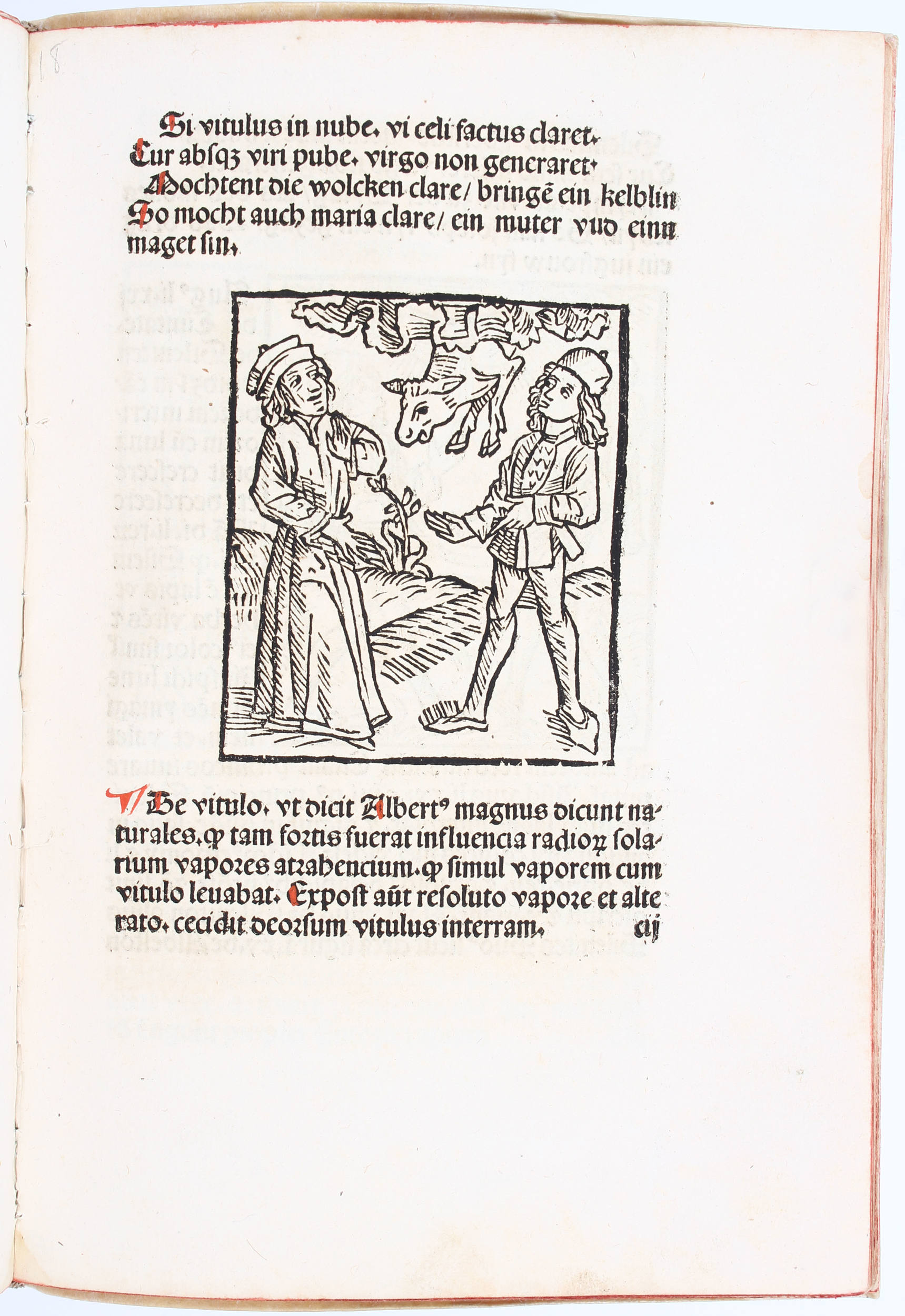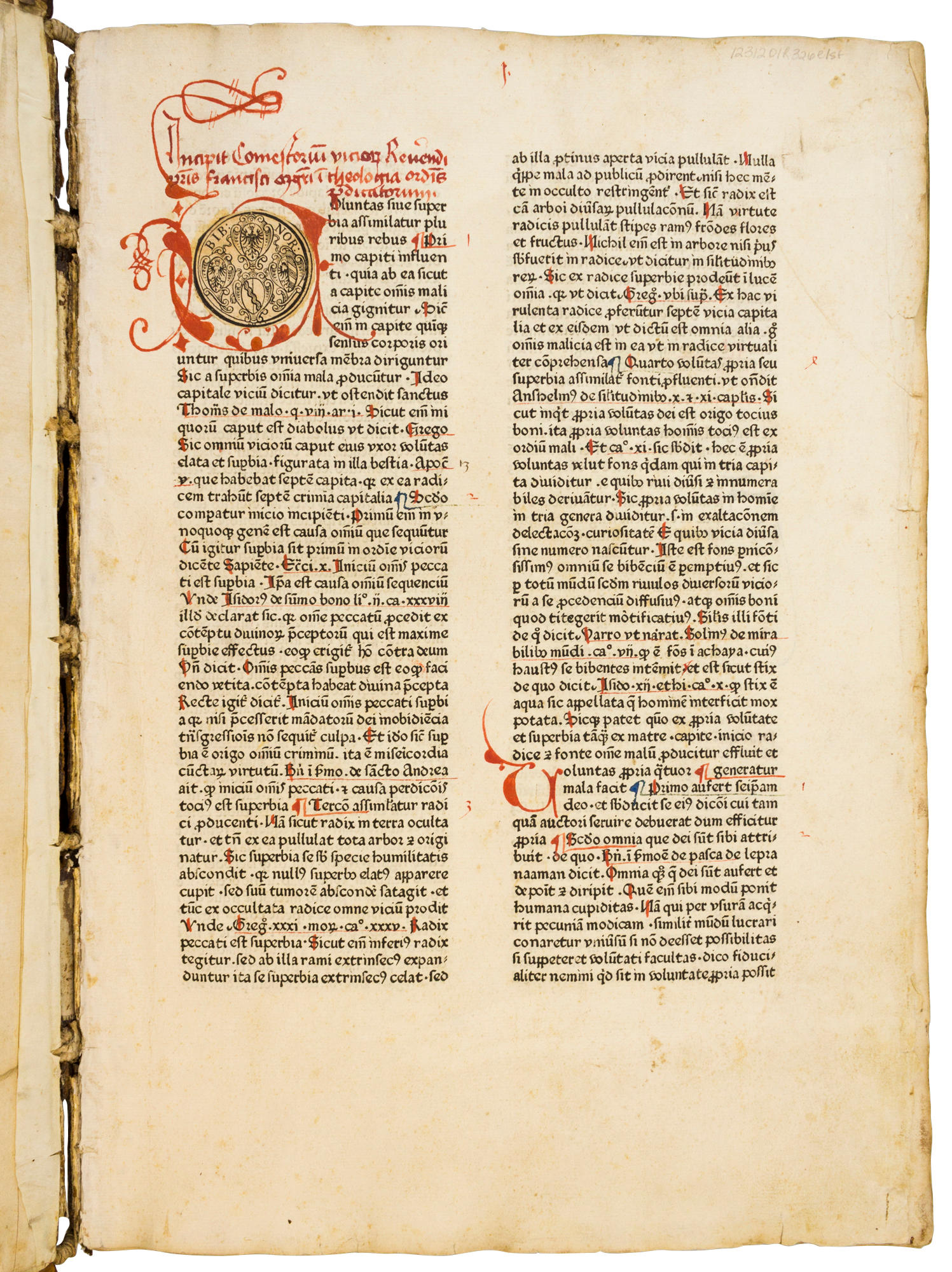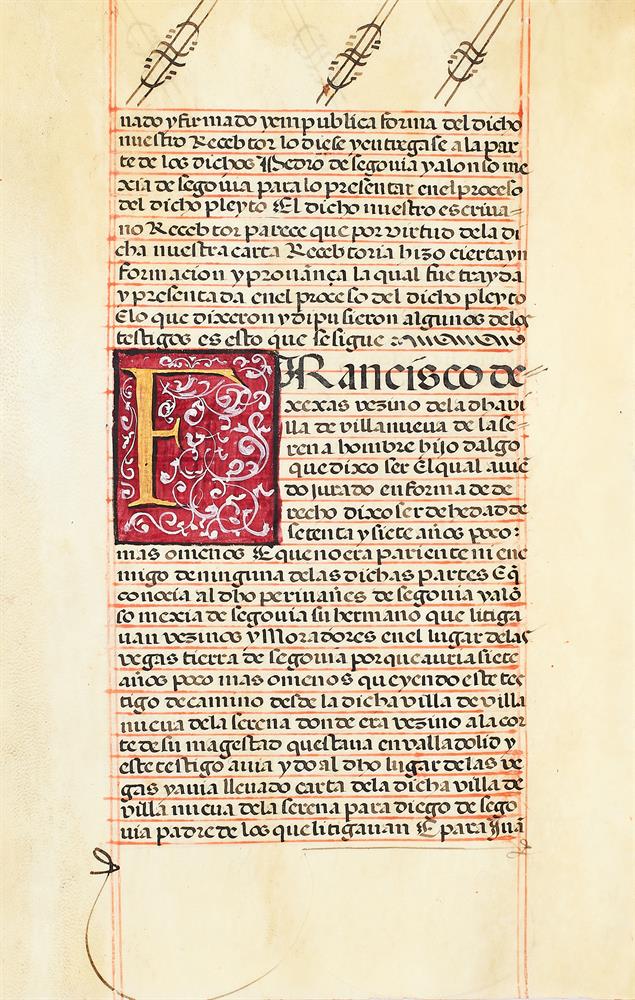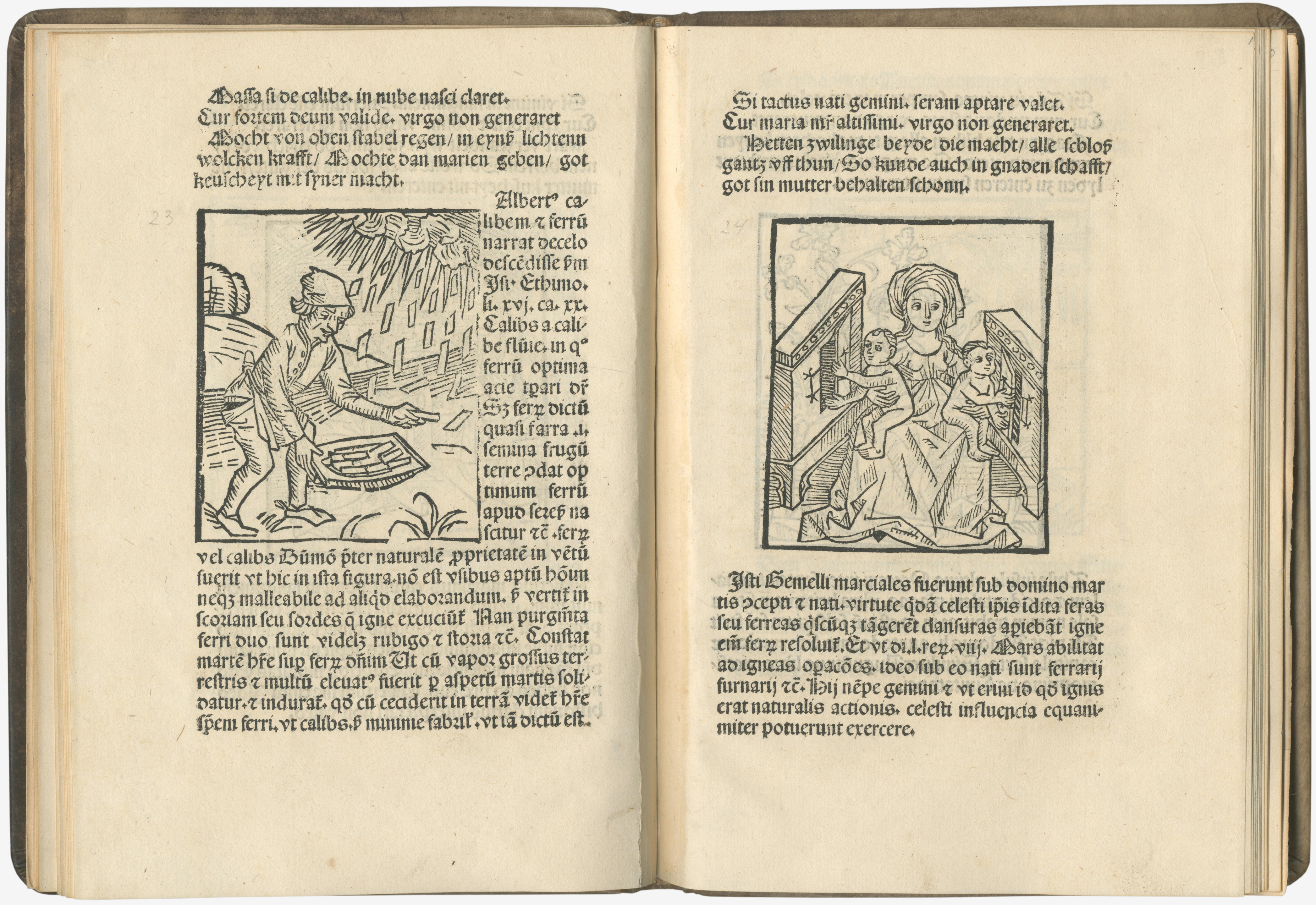FRANCISCUS DE RETZA (c.1343-1427). Comestorium vitiorum . Nuremberg: [Johann Sensenschmidt and Heinrich Kefer for Heinrich Rummel], 1470. The first edition of Franciscus’s major work on the seven deadly sins; a tall, fresh copy in a contemporary Nuremberg binding. Franciscus also treats of the corresponding virtues. This is the first dated book printed at Nuremberg; it appeared the same year as a small Gerson tract from the same press. Sensenschmidt, Nuremberg's prototypographer, probably learned to print at Mainz and may have worked with Pfister on the 36-line Bible at Bamberg before establishing his own shop at Nuremberg in about 1469. Interestingly, the colophon here quotes a phrase from the Catholicon of Balbus printed at Mainz in 1460, of which Johannes Gutenberg is the probable author. There is no doubt that this volume was bound at Nuremberg, but its tools appear to belong to three different shops: the Carmelite convent (Kyriss shop 22, active ca. 1462-1491, Schwenke-Sammlung Adler 52 and 407a); the Carthusian monastery (Kyriss shop 23, Schwenke-Sammlung Blattwerk 351 and Granatapfel 112a); and the Nuremberg "Laubstab" shop (Schwenke-Sammlung, Einhorn 29 and Hirsch 20). The internal blank leaves have been cancelled, as in most copies; the intention to cancel these leaves is confirmed by the printed index, where the foliation assumes their absence. HC 13884*; BMC II, 403 (IC. 7003); BSB-Ink F-250; GW 10270; Goff R-150. Royal folio (404 x 290mm). Collation: [1 10 2 12 3 10 4-5 8 ; 6-10 10 (-10.10, blank); 11-14 10 15 12 (-15.12, blank); 16-18 10 19 12 (-19.12, blank); 20-23 10 24 8 (-24.1, blank); 25-28 10 29 12 ] text, 5/8v blank, 29/6r index,-12 blank). 285 leaves (of 286, without final blank). 49 lines, double column. Type: 1:114G. 9-line initial space opening text, 3- and 4-line initial spaces elsewhere. 3-line title and opening initial in red with flourishes, other initials alternating in red and blue (the spaces intended for red initials designated by a brown ink mark), paragraph marks in red or blue, manuscript foliation in headline, capital strokes and underlining in red. Traces of contemporary quiring in brown ink in lower right corners of rectos. 3 pinholes per page (2 in upper margin, one in lower inner margin) visible in many sheets. (Slight dust-soiling in upper margins.) Contemporary Nuremberg blind-stamped calf over wooden boards, diapered central panel of upper cover with unicorn, double-headed eagle, bird and two floral ornament stamps, outer border of garland with tufted finials, lower cover paneled with fillets, vellum title label under horn with brass framing strips, embossed brass catches, chain staple hole at top of lower board, early paper label on front cover, later paper spine label, vellum quire guards (worn, part of horn missing, lacking center- and cornerpiece bosses). Provenance : Nuremberg, City Library: early armorial paper booklabel mounted in first initial space – Albert Ehrman (1890-1969, his and Broxbourne Library bookplates, monogram and penciled notes; sale Sotheby's, 8 May 1978, lot 396) – [to Lathrop Harper] – Helmut N. Friedlaender (bookplate; his sale, Christie's New York, 23 April 2001, lot 49).
FRANCISCUS DE RETZA (c.1343-1427). Comestorium vitiorum . Nuremberg: [Johann Sensenschmidt and Heinrich Kefer for Heinrich Rummel], 1470. The first edition of Franciscus’s major work on the seven deadly sins; a tall, fresh copy in a contemporary Nuremberg binding. Franciscus also treats of the corresponding virtues. This is the first dated book printed at Nuremberg; it appeared the same year as a small Gerson tract from the same press. Sensenschmidt, Nuremberg's prototypographer, probably learned to print at Mainz and may have worked with Pfister on the 36-line Bible at Bamberg before establishing his own shop at Nuremberg in about 1469. Interestingly, the colophon here quotes a phrase from the Catholicon of Balbus printed at Mainz in 1460, of which Johannes Gutenberg is the probable author. There is no doubt that this volume was bound at Nuremberg, but its tools appear to belong to three different shops: the Carmelite convent (Kyriss shop 22, active ca. 1462-1491, Schwenke-Sammlung Adler 52 and 407a); the Carthusian monastery (Kyriss shop 23, Schwenke-Sammlung Blattwerk 351 and Granatapfel 112a); and the Nuremberg "Laubstab" shop (Schwenke-Sammlung, Einhorn 29 and Hirsch 20). The internal blank leaves have been cancelled, as in most copies; the intention to cancel these leaves is confirmed by the printed index, where the foliation assumes their absence. HC 13884*; BMC II, 403 (IC. 7003); BSB-Ink F-250; GW 10270; Goff R-150. Royal folio (404 x 290mm). Collation: [1 10 2 12 3 10 4-5 8 ; 6-10 10 (-10.10, blank); 11-14 10 15 12 (-15.12, blank); 16-18 10 19 12 (-19.12, blank); 20-23 10 24 8 (-24.1, blank); 25-28 10 29 12 ] text, 5/8v blank, 29/6r index,-12 blank). 285 leaves (of 286, without final blank). 49 lines, double column. Type: 1:114G. 9-line initial space opening text, 3- and 4-line initial spaces elsewhere. 3-line title and opening initial in red with flourishes, other initials alternating in red and blue (the spaces intended for red initials designated by a brown ink mark), paragraph marks in red or blue, manuscript foliation in headline, capital strokes and underlining in red. Traces of contemporary quiring in brown ink in lower right corners of rectos. 3 pinholes per page (2 in upper margin, one in lower inner margin) visible in many sheets. (Slight dust-soiling in upper margins.) Contemporary Nuremberg blind-stamped calf over wooden boards, diapered central panel of upper cover with unicorn, double-headed eagle, bird and two floral ornament stamps, outer border of garland with tufted finials, lower cover paneled with fillets, vellum title label under horn with brass framing strips, embossed brass catches, chain staple hole at top of lower board, early paper label on front cover, later paper spine label, vellum quire guards (worn, part of horn missing, lacking center- and cornerpiece bosses). Provenance : Nuremberg, City Library: early armorial paper booklabel mounted in first initial space – Albert Ehrman (1890-1969, his and Broxbourne Library bookplates, monogram and penciled notes; sale Sotheby's, 8 May 1978, lot 396) – [to Lathrop Harper] – Helmut N. Friedlaender (bookplate; his sale, Christie's New York, 23 April 2001, lot 49).

.jpg)




.jpg)




Testen Sie LotSearch und seine Premium-Features 7 Tage - ohne Kosten!
Lassen Sie sich automatisch über neue Objekte in kommenden Auktionen benachrichtigen.
Suchauftrag anlegen